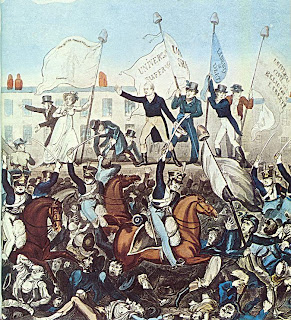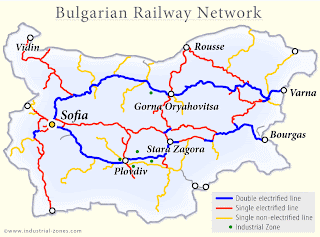 Is there such a thing as a "mentalité" of a people, group, or nation? Take these young people at an Iowa potluck supper, or the traders pictured below at the Chicago Board of Trade -- is there a midwestern mentalité that they can be said to share? What factors might be comprised by such a concept? What forms of variation must we expect within a group sharing a mentalité? And what are the social mechanisms through which these hypothesized forms of shared experience and thought are conveyed?
Is there such a thing as a "mentalité" of a people, group, or nation? Take these young people at an Iowa potluck supper, or the traders pictured below at the Chicago Board of Trade -- is there a midwestern mentalité that they can be said to share? What factors might be comprised by such a concept? What forms of variation must we expect within a group sharing a mentalité? And what are the social mechanisms through which these hypothesized forms of shared experience and thought are conveyed?First, what does the concept mean? Most basically, a mentalité is thought to be a shared way of looking at the world and reacting to happenings and actions by others, distinctive from other groups and reasonably similar across a specific group.
 This characterization folds together a number of things: cognitive frames for understanding the world, values and norms around which one organizes one's actions, and a repertoire of reactions and responses to scenarios in the world. And all of this comes together in the form of a signature form of consciousness and behavior. A mentalité shapes the individual's experience of the world, and it provides a specific foundation for one's choices and actions as events in one's world unfold. And a mentalité is thought to be shared across a social group, so it is not simply a set of individual and idiosyncratic mental attitudes.
This characterization folds together a number of things: cognitive frames for understanding the world, values and norms around which one organizes one's actions, and a repertoire of reactions and responses to scenarios in the world. And all of this comes together in the form of a signature form of consciousness and behavior. A mentalité shapes the individual's experience of the world, and it provides a specific foundation for one's choices and actions as events in one's world unfold. And a mentalité is thought to be shared across a social group, so it is not simply a set of individual and idiosyncratic mental attitudes.Historians of the Annales school (see an earlier posting) gave special attention to the task of reconstructing the mentalité of people and groups of the past. Durkheim's ideas about the social world seem to be in the background in the focus offered by Marc Bloch or Jacques Le Goff on this aspect of history's tapestry -- though the Annales approach seems to be more psychological than Durkheim would have preferred. Emmanuel Le Roy Ladurie, for example, sought to capture the mentalité of the peasants of Montaillou in his book of that title, offering substantial commentary on their attitudes towards death, sex, and religion. Lawrence Stone writes of Le Roy Ladurie's "sheer brilliance in the use of a unique document to reconstruct in fascinating detail a previously totally unknown world, the mental, emotional, sexual, and religious life of late thirteenth-century peasants in a remote Pyrennean village" (review in the New York Review of Books by Lawrence Stone of Le territoire de l'historien, The Territory of the Historian, and Carnival in Romans). And the sorts of features of "worldview" that are often invoked in describing a mentalité include superstition and magical beliefs. A fundamental clash of mentalités arises in the conjunction of traditional, magical thinking and modern, scientific thinking in the nineteenth century. (Relevant snippets from The Annales School: Critical Assessments can be found here.)
Several questions are pressing when we consider this concept. First, is the governing idea of underlying variation of worldviews across cultures and times valid in any non-superficial sense? Trivially, of course, we recognize that tastes and morés vary across places and cultures. This was one of Montesquieu's insights. But is there a more fundamental way in which Scots experience the world differently from Basques or Yoruba? Or are the differences associated with tastes and manners simply an overlay that sits on top of a more fundamental human similarity? This question pushes us towards the debate between advocates of "human nature" against the "historicists," according to whom the most basic features of human cognition and action are contingent and historically shaped.
Let's go out on a limb here for the moment and postulate that even fairly deep aspects of cognition and behavior are historically and culturally variable. Deep aspects of "human nature" are plastic and subject to historical construction. This leaves it open that there may be elements of common human experience while postulating a deep-running plasticity as well. And this leaves it open, in turn, that there is a useful place in historical analysis for the idea of a mentalité.
Second, we need to reflect upon the ways in which adherence to a mentalité should be expected to vary across individuals, places, and cohorts. And, of course, we should expect variation, since every human attribute comes in a range across a population -- and even more so for learned traits. So if we think that a mentalité comprises a cognitive framework, a value system, and a set of expectations about behavior -- we should also expect that there will be a range of ways in which these items are instantiated in different people within the same group.
Third, we need to attempt to trace out some of the mechanisms through which a mentalité is reproduced and maintained across generations and places. We need an account of the microfoundations of mentalité, along the lines of an earlier posting on social practices. We've already sketched some of these mechanisms in prior postings. But the fundamental idea is that there is a range of institutions through which children and young people acquire mental skills and content, both formal and informal -- schooling, religious education, family practices, and local traditions, for example. So for there to be a persistent mentalité for a population, there must be a reasonably consistent delivery system across the population that transmits this ensemble of items. And sociologists and historians need to be able to uncover some of the specifics of these institutions.
And, fundamentally, how would we confirm the notion that a population possesses a mentalité? How would we support a claim like this: "medieval villagers of the Vosges possessed a mentalité that distinguished them from their modern counterparts and their contemporaries in other regions"? There are several answers we might give: Robert Darnton used some of the tools of ethnography to get at the thoughts of the agents of the great cat massacre in 1740. Or we might imagine a contemporary sociologist using some of the many-country surveys of values (World Values Survey) as a basis for judging that French and Italian people in 1960 possessed significantly different moral frameworks with respect to certain subjects. Or we might rely on our own acquaintance with multicultural friends --- perhaps certain Danish people and certain Nigerians -- and simply remark internally, "How differently they seem to perceive and react to the world."
Finally, we might at least consider the idea that the globalization of communication, transportation, and education has substantially reduced the variability of worldviews and cognitive frameworks, so that modern consciousness is much more uniform than medieval consciousness and thought.










